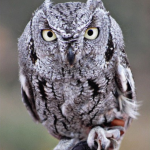
Angella Parker
Arizona-Sonora Desert Museum Digital Library
The Western Screech Owl (Otus kennicotti) breeds throughout the western U.S., from southern Canada to Baja California, and other parts of Mexico. This little owl is the fourth and smallest of the raptors I handle and interpret at the Arizona-Sonora Desert Museum. I’ve written previously about the Harris’ Hawk, the Barn Owl, and the American Kestrel.
The Western Screech Owl has a body length of 8- to 10 inches, and a wingspan of 20- to 24 inches. (The infamous Cactus Ferruginous Pygmy Owl is slightly smaller.) The yellow eyes are very penetrating. When alert or excited, it raises some feathers on its head – “ear” tufts. The owl is usually gray and streaked with black and white (there is a red race). The only other owl in this region it may be confused with is the Elf Owl, which is much smaller (5 inches in length) and lacks the ear tufts. The screech owl’s toes are zygodactylous (two pointed forward, two pointing backwards).
Screech owls generally do not migrate. They are cavity nesters, so you might see one peeking out of a hole in a saguaro cactus. (They will also nest in boxes.) The female lays 4- to 6 eggs, each about 2- to 3 days apart. The chicks hatch after about 26 days and open their eyes after about a week. The female broods the chicks for two weeks while the male brings food. The chicks stay in the nest for about five weeks, all the time being fed by their parents. Life expectancy in the wild is 4- to 6 years, but captive birds are known to have reached an age of 18 years.
The Screech owl is a fierce predator and will attack prey much larger, relative to its size, in comparison with other owls. The screech owl will attack large Norway rats, mice, lizards, insects, smaller birds, scorpions, spiders, ground squirrels, and fish. Its normal habitat in the desert is the wooded areas near mountains, or along tree-lined rivers. In wooded areas, the owl’s dull color makes good camouflage.
Despite its name, the owl doesn’t screech. Instead, it has a series of trilling calls. Screech owls have keen hearing which help in capturing prey, but their hearing is not as specialized as that of the Barn Owl.
Copyrighted by Jonathan DuHamel. Reprint is permitted provided that credit of authorship is provided and linked back to the source.
See also:
